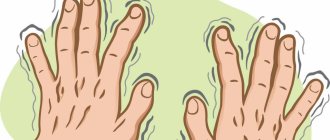Article:
We all have something that worries us or makes us nervous in our daily lives.
This anxiety can range from mild excitement before meeting someone you haven’t seen for a long time until the onset of “bear sickness” before the exam. In principle, both are normal for a person. But what if this nervousness becomes constant and begins to interfere with your normal life? Worried thoughts turn into anxious thoughts, anxiety overwhelms you, and thoughts become more and more intrusive?
These are signs of uninvited neurosis, and it’s good if it’s just neurosis and not a more serious mental disorder.
If something similar occurs among family members, pay special attention to the child’s well-being. Firstly, due to hereditary predisposition, he falls into a risk group. Secondly, he absorbs the behavior of adults like a sponge, copying, assimilating and repeating patterns of neurotic behavior.
CHARACTERISTIC SIGNS OF NEUROSIS IN INFANTS:
- Severe redness of the skin when screaming or crying
- Mild excitability and movement disorders
- Urinating too frequently
- Pallor, frequent colic
CHARACTERISTIC SIGNS OF NEUROSIS IN CHILDREN/TEENAGERS:
- Suspiciousness, anxiety about ordinary reasons
- Difficulty switching attention
- Obsessing over unpleasant events or experiences. Obsessive symptoms often occur in adolescence, later developing into obsessive-compulsive disorder.
- Obsessive movements, actions
- Obsessive fears
- Enuresis
- Thumb sucking
- Nail biting
- Stuttering
- Frequent tantrums for no serious reason
- Withdrawal, lethargy, as evidence of exhaustion from internal experiences
- Sleep disorders
- Irritability
- Anger
- Feeling of constant hostility from the outside world
- Feeling vulnerable
- Excessive shyness
NEUROTIC BEHAVIOR IN CHILDREN/ADOLENTS
Neurosis forces a person to behave in accordance with the level of anxiety, and sometimes suspiciousness, that is characteristic of a neurotic. This is the intensity of reactions and experiences that not only differ from the reactions of healthy people, but, most importantly, interfere with the personal life and professional activities of the patient himself.
FORMS OF NEUROSES IN CHILDREN:
In children under the age of 6-7 years, neurosis is detected, as a rule, only in the form of individual symptoms. As a rule, this is a demonstration of helplessness in the form of rolling on the floor screaming and crying, while they may hit their head, arms and legs on the floor. An equally striking manifestation of neurosis in children is neurotic stuttering, (logoneurosis) most typical for boys from 3 to 6 years old, i.e. during the period when speech formation occurs.
Essentially, this is a convulsive contraction of the muscles responsible for speech.
At school age, the presence of neurosis becomes clearly visible: it is pronounced anxiety or fears, because of which the child is ready to miss classes in clubs or school, refuse to go for walks, cry, withdraw into himself, and have difficulty falling asleep. Often there are such manifestations as twitching of the hands, sniffing or a certain stupor, accompanied by a decrease in self-esteem, unnatural movements, changes in facial expressions, decreased appetite, insomnia and tearfulness.
Another type of neurosis in adolescents is neurotic tics, which are more common in boys. This is either frequent blinking, or twitching of noses, eyebrows, shrugging of shoulders, and the like. There are also respiratory tics, as a persisting habit after suffering from a cold: coughing, sniffing, etc.
Enuresis of a psychogenic nature, as a reaction to psychological trauma or mental stress that is excessive for the child.
In adolescence, a neurotic state can manifest itself in constant irritation, incontinence and grumpiness unusual for age. At the same time, girls may predominantly experience fear of hypothetical diseases.
EXAMPLE OF NEUROTIC BEHAVIOR
An 8-year-old boy, usually moderately active, with good self-esteem, having gone with his parents to a cottage community for the summer, was faced with a situation where neighboring children of 10-12 years old refused to play with him during walks, citing the fact that he too small. His attempts to establish contact with them every walk led to even more aggressive refusals on their part. As a result, he felt like an outcast.
By mid-summer, the situation had changed: his peers arrived, who friendly invited him for walks and joint games.
During a stressful situation for him, his psyche resisted, forcing him to come up with new ways to establish communication, and he felt upset, resentful and angry, which was a normal, natural reaction to the situation. However, in the second half of the summer, his parents noticed that he began to withdraw more and more into himself, silently sad in solitude, his appetite decreased and the desire to participate in games with peers disappeared. This is how the boy developed neurosis.
I’ll say right away that the parents paid attention to this in time, and with the help of a psychotherapist, they quickly returned the boy to a healthy, cheerful state.
Neurotic behavior can also be caused by other disorders of the emotional and mental sphere. It is important to understand that the development of neurosis can make a neurotic person more prone to what are called “internalizing disorders”, for example:
- Generalized anxiety disorder
- Depression
- Obsessive-compulsive disorder
- Social phobia
- Post-traumatic stress disorder
- Panic disorder
- Sociopathic personality disorder
Symptoms of neurosis do not include delusions or hallucinations, which are symptoms of psychotic disorders in which the patient loses touch with reality. Instead, he dwells on his own negative emotions and failures, real or imagined.
Causes of development of astheno-neurotic syndrome
The main cause of this type of disease is the presence of a disorder of the autonomic nervous system, which, under the influence of frequent stress, severe lack of rest and other factors, develops into a full-fledged neurosis. Since the vast majority of modern people live in a frantic pace of life, are exposed to stress every day and everywhere, suffer from bad habits and, as a rule, eat on the go, not particularly caring about a balanced diet, this aggravates existing disorders and ultimately leads to the emergence of astheno-neurotic syndrome.
The most susceptible to developing this disorder are vulnerable people and children who react strongly to any failures and irritants, have also experienced psychological trauma, have problems with self-esteem, are brought up in an authoritarian style, or suffer from high parental expectations.
The number of prerequisites for the development of astheno-neurotic syndrome is so diverse that it is not always possible to accurately determine which of them caused its occurrence. The most common ones are:
- severe and frequent stress, especially tragic, deeply experienced events;
- regular overwork with lack of rest;
- infectious diseases accompanied by a rise in body temperature to high values, and, consequently, intoxication of the body;
- smoking, alcohol abuse, drug use;
- diseases of the endocrine system, in particular the thyroid, pancreas, and genital organs;
- poor nutrition, leading to a deficiency of not only vitamins and minerals, but also a sharp imbalance between consumed fats, proteins and carbohydrates;
- lability of the psyche with a tendency towards perfectionism;
- traumatic brain injuries.
In children, the main causes of the development of astheno-neurotic syndrome are:
- fetal hypoxia;
- birth injuries;
- intrauterine infections;
- the presence of malformations of the nervous system;
- the presence of bad habits in the mother during pregnancy.
Astheno-neurotic syndrome was previously diagnosed in children, but today the number of such cases has increased significantly. This is also facilitated by lifestyle changes and increased stress levels. Even preschoolers can become victims of this disorder, not to mention school-age children who have a huge mental load.
RELATIONSHIP BETWEEN NEUROSIS AND PERSONALITY CHARACTERISTICS
Western expert Alyson Powell Key argues that neurosis is not always a disease, since it is characteristic of a certain type of personality and can simply be a personality trait. This is not entirely true. Indeed, there are personalities accentuated by hysterical, astheno-neurotic, schizoid and other types. Their neurosis manifests itself depending on the accentuation of the personality, which is reflected in the names of the main types of neurosis: hysterical neurosis, neurasthenia and obsessive-compulsive neurosis.
- Hysteria. In children, it is expressed by a violent reaction to the lack of immediate fulfillment of their desires. Such children usually tend to manipulate their parents.
- Neurasthenia. In children it manifests itself primarily in increased fatigue, headaches, weakness and irritability. Similar in symptoms to VSD.
- Obsessive states. In children they are found in the form of fears, obsessively repetitive actions or thoughts.
In any case, neurosis is a psychogenic disorder, i.e. provoked by external factors that affect the functioning of the psyche, which means that the disease is curable.
Where can I go for help?
Our Center offers assistance from qualified child psychiatrists. If you think that your child has neurasthenia, please consult our specialists. Neurasthenia is a diagnosis made by a doctor.
At the appointment, the doctor analyzes the situation in the family, collects a complete history of the disease, and identifies predisposing indicators. To achieve positive treatment results, an integrated approach is used. First of all, it is necessary to get rid of the traumatic factor, then reduce physical and psychological stress.
You can make an appointment with a child psychiatrist in Saratov from 8.00 to 20.00 by calling (8452) 244-000. Reception is by appointment only.
TREATMENT OF NEUROSIS IN CHILDREN AND ADOLESCENTS
A psychotherapist specializing in the treatment of neuroses in children and adolescents primarily involves parents to find out the causes of neurosis in their children. Until the cause is eliminated, there is no talk about the effectiveness of treatment. For example, if a child is diagnosed with logoneurosis due to the constant scandals of his parents in his presence, then the first thing that is necessary for his recovery is to rid him of the presence of such scenes.
In the treatment of neuroses in children and adolescents, as a rule, cognitive behavioral and art therapy are used, which make it possible to get rid of anxiety that causes internal nervous tension on a conscious and unconscious level.
In addition, a psychotherapist or psychologist trains parents in behavior that promotes the child’s recovery and the prevention of neuroses.
How can parents help?
According to statistics, about 30% of people have experienced a similar condition at least once in their lives, and some may be experiencing it now. But what does this have to do with parents? You can’t let your child not go to school?! The child needs to develop diversified, which is helped by the sections! The child needs to be able to resolve conflicts on his own! And how then can we pull a child out of the vicious circle of problems if we cannot remove all this from his life?
To begin with, you should give your child love and support, and treat his problems and needs with understanding. They may look stupid though. Well, yes. We understand that love for a classmate will pass in a couple of years and this problem will soon go away, but while it is there, it is real for the child.
Then you should rid the child of overprotection - which will make him more independent and allow him to quickly learn to solve his problems. If you think that you simply love and care for your child, then look at your actions through the prism of one simple expression that distinguishes between love and overprotection: “everything that a child should be able to do at his age, he should do himself.” Does your 7 year old child have trouble tying his shoelaces? Hardly! Then let him handle it on his own.
The next step is to return the child’s right to childhood. School, clubs, sections, household chores - this is all good and correct, but the child must have a childhood. There should be time for games, for relaxation, for friends. A child should not always be exhausted from trying to please his parents. Otherwise, he will cause a lot of difficulties for you, and then, if you are lucky, as an adult he will be able to allow himself to live his own life, which most often happens after a long work with a psychotherapist.
Diagnosis and treatment of astheno-neurotic syndrome
Diagnosis of the disease does not require complex procedures. To identify neurasthenia, a survey of a neurologist is sufficient, but it is important that the patient is completely frank and does not hide any details. For an experienced specialist, it is not difficult to determine astheno-neurotic syndrome only from the existing clinical picture in the first stages of its development, not to mention the third. Therefore, treatment is prescribed immediately.
The main difficulty in diagnosis is discovering the cause or complex of factors that provoked the development of the disease. This point is always given paramount importance, since it is by influencing the cause that the existing problem can be completely solved, while symptomatic therapy will give an effect only for a while. But, unfortunately, it is not always possible to immediately identify all factors.
Treatment of astheno-neurotic syndrome is always complex and involves:
- drug therapy;
- psychotherapy;
- lifestyle corrections;
- therapeutic massage or manual therapy;
- physiotherapeutic procedures.
When a disease is detected in a child, it is usually enough to adjust the lifestyle. Eliminating frankly harmful foods and caffeine-containing drinks from the menu and replacing them with freshly squeezed juices, fruits, vegetables, berries, as well as avoiding prolonged viewing of TV, computer games, etc. usually helps bring the child’s condition back to normal. Long walks in the fresh air are very beneficial, especially before bed. At the same time, it is important to establish a daily routine and strictly adhere to it, so that the baby goes to bed at the same time and can fully rest.
Drug therapy and physical therapy
The nature of drug therapy is selected in accordance with the severity of chronic fatigue syndrome. Therefore, if at the 1st stage of its development it is enough to use herbal teas or traditional medicine in combination with taking complex vitamin preparations, then with more serious changes the prescription of a number of sedatives and antidepressants is required.
Thus, drug treatment for chronic fatigue syndrome may include:
- sedatives (sedatives) of plant origin, including tinctures of valerian, motherwort and complex preparations such as Persen - reduce the excitability of the nervous system and help reduce anxiety;
- antidepressants - prescribed when there is no effect from taking sedatives, they quickly relieve anxiety, calm, but can provoke the development of side effects;
- antiasthenic drugs – increase vitality and restore energy;
- nootropics – improve brain function, increase the ability to concentrate, improve memory and the course of thought processes;
- adaptogens, including Eleutherococcus tincture – help increase the body’s ability to adapt to changing living conditions;
- vitamins – have a general strengthening effect on the body.
The effect of the drugs is supplemented by the appointment of physiotherapeutic procedures. Most often, for astheno-neurotic syndrome, it is recommended to undergo a course of reflexology and electrosleep sessions.
Many people enjoy aromatherapy. In the absence of allergies, no one can prohibit the patient from using this treatment method to normalize the psychological state and overcome existing problems. But aromatherapy can only act as an auxiliary method of treatment, and does not replace the therapy regimen prescribed by the doctor.
Psychotherapy
Since personality traits and psychological factors play a large role in the development of astheno-neurotic syndrome, treatment of the disease, especially in the later stages of development, is impossible to imagine without the help of a psychotherapist or psychologist. This specialist will help to identify deep-seated personality problems, traumatic situations and work through them in order to eliminate the pressure they create.
It is almost always recommended that patients find an outlet for themselves - some kind of hobby that will bring pleasure and help them relax. This could be any activity from knitting, drawing, spending time with a pet, collecting coins, or reading.
Particularly effective elements of psychotherapy for patients with astheno-neurotic syndrome are art therapy and sand therapy. Drawing in general helps to cope with tension and throw out any accumulated emotions and experiences, and often it helps to get to the bottom of the problem and find an easy way to solve it.
Breathing exercises are of great benefit for people with chronic fatigue syndrome, as it has a relaxing effect on the body and puts you in a good mood.
Lifestyle correction
Since a person’s lifestyle plays an important role in the development of astheno-neurotic syndrome, much attention is paid to its correction. It is often recommended:
- to refuse from bad habits;
- increase the level of physical activity, cardio exercise and yoga are especially useful;
- avoid overexertion;
- alternate work with rest;
- take vitamins;
- pay attention to nutrition.
The diet for astheno-neurotic syndrome consists of avoiding the use of synthetic energy drinks, as well as minimizing the consumption of coffee, tea, and other caffeine-containing drinks. They are replaced with herbal infusions, hawthorn or rose hip infusion, tea with chamomile, mint, lemon balm, etc. Be sure to enrich the daily diet with fresh fruits and vegetables. At the same time, it is advisable to minimize the amount of fried and fatty foods and baked goods consumed.
Therapeutic massage and manual therapy
Both procedures involve manual pressure on the soft tissues of the back, which provides a pronounced relaxing and healing effect. But manual therapy differs from therapeutic massage in that during the session the specialist also works on the spine. As you know, the quality of functioning of the whole organism and especially the nervous system depends on its condition. Therefore, manual therapy sessions make it possible to influence the main link in the development of chronic fatigue syndrome – autonomic disorders.
Consequently, both therapeutic massage and manual therapy have a positive effect on the patient’s recovery rate. But if for mild forms of the disorder only therapeutic massage is sufficient, then for more serious disorders or the desire to achieve maximum effect, preference should be given to manual therapy.
Thus, almost everyone can encounter a disease such as astheno-neurotic syndrome. In the initial stages of development, it cannot be considered a life-threatening condition, but if the problem is ignored, it can still become a serious disorder. But timely, comprehensive treatment will allow you to completely cope with it and return to a normal, fulfilling life.
4 1 vote
Article rating








